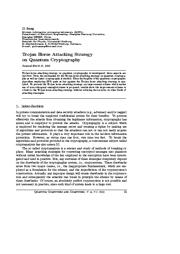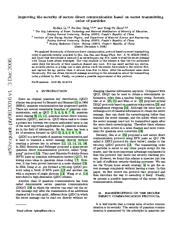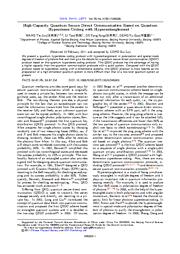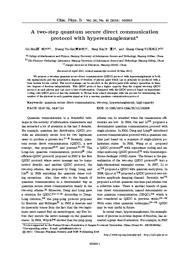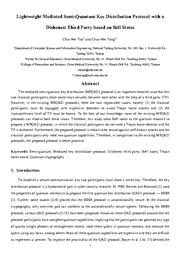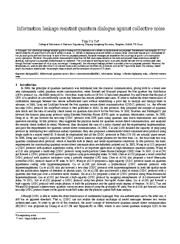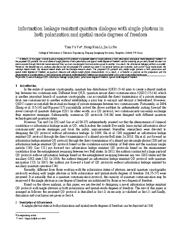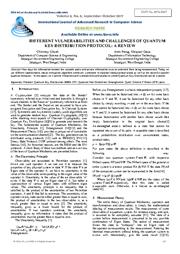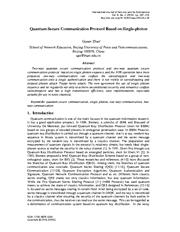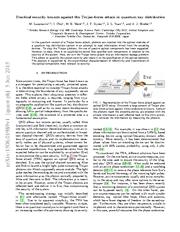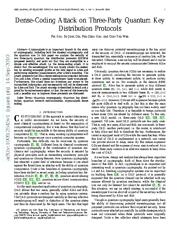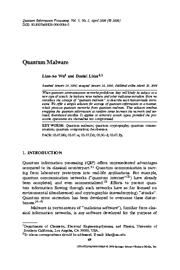The Internet Archive has a preservation copy of this work in our general collections.
The file type is application/pdf.
Filters
Robustness of two-way quantum communication protocols against Trojan horse attack
[article]
2005
arXiv
pre-print
We discuss the robustness of two-way quantum communication protocols against Trojan horse attack and introduce a novel attack, delay-photon Trojan horse attack. ...
Moreover, we present a practical way for two-way quantum communication protocols to prevent the eavesdropper from stealing the information transmitted with Trojan horse attacks. ...
In this way, Alice can improve the security of two-way quantum communication protocols against the Trojan horse attacks. ...
arXiv:quant-ph/0508168v1
fatcat:3lyrpxcdm5fixbklt4zyyefyq4
TROJAN HORSE ATTACKING STRATEGY ON QUANTUM CRYPTOGRAPHY
2003
The Physics of Communication
Trojan horse attacking strategy on quantum cryptography is investigated, three aspects are involved. ...
First, the mechanism for the Trojan horse attacking strategy on quantum cryptography as well as classic cryptography is studied. ...
Introduction In private communication and data security attackers (e.g., adversary and/or ragger) will try to break the employed confidential system for their benefits. ...
doi:10.1142/9789812704634_0032
fatcat:li4jaxrnebdspiplrdts4bbkd4
Improving the security of secure direct communication based on the secret transmitting order of particles
2006
Physical Review A. Atomic, Molecular, and Optical Physics
A 73, 022338 (2006)], and found that this scheme is insecure if an eavesdropper, say Eve, wants to steal the secret message with Trojan horse attack strategies. ...
We analyzed the security of the secure direct communication protocol based on secret transmitting order of particles recently proposed by Zhu, Xia, Fan, and Zhang [Phys. Rev. ...
There are two kinds of Trojan horse attack strategies. One is the invisible photon eavesdropping (IPE) scheme proposed by Cai [26] and the other is the delay-photon Trojan horse attack [5, 27] . ...
doi:10.1103/physreva.74.054302
fatcat:en7w3gu5krgetdurjzv4w4fhwy
High-Capacity Quantum Secure Direct Communication Based on Quantum Hyperdense Coding with Hyperentanglement
2011
Chinese Physics Letters
(QSDC) protocol based on this quantum hyperdense coding protocol. ...
This QSDC protocol has the advantage of having a higher capacity than the quantum communication protocols with a qubit system. ...
Then we give a QSDC protocol based on this quantum hyperdense coding protocol and discuss its security against Trojan horse attack strategies. ...
doi:10.1088/0256-307x/28/4/040305
fatcat:beo44cmst5dkhoelfq3zvkdw7e
A two-step quantum secure direct communication protocol with hyperentanglement
2011
Chinese Physics B
Compared with the QSDC protocol based on hyperdense coding, this QSDC protocol has the immunity to Trojan horse attack strategies with the process for determining the number of the photons in each quantum ...
signal as it is a one-way quantum communication protocol. ...
with Trojan horse attack strategies. ...
doi:10.1088/1674-1056/20/10/100309
fatcat:cvydv3ljrfgjbc7qgepc2ktjiu
Lightweight Mediated Semi-Quantum Key Distribution Protocol with a Dishonest Third Party based on Bell States
[article]
2020
arXiv
pre-print
However, in the existing MSQKD protocols, there are two improvable issues, namely (1) the classical participants must be equipped with expensive detectors to avoid Trojan horse attacks and (2) the trustworthiness ...
Therefore, this study takes Bell states as the quantum resource to propose a new MSQKD protocol, in which the classical participants do not need a Trojan horse detector and the TP is dishonest. ...
Moreover, the one-way quantum communication strategy is adopted to design the protocol, and thus the proposed protocol is immune to Trojan horse attacks, implying that the classical participants do not ...
arXiv:1909.02788v2
fatcat:2vs6nz433jaxpdva345ywmxq6i
Information leakage resistant quantum dialogue against collective noise
2014
Science China Physics Mechanics and Astronomy
Moreover, the detailed security analysis also shows that Eve's several famous active attacks can be effectively overcome, such as the Trojan horse attack, the intercept-resend attack, the measure-resend ...
In this paper, two information leakage resistant quantum dialogue (QD) protocols over a collective-noise channel are proposed. ...
Now its effectiveness against Eve's several famous active attacks is demonstrated in detail as follows. ①The Trojan horse attacks There are two kinds of Trojan horse attack strategies, i.e., the invisible ...
doi:10.1007/s11433-014-5566-2
fatcat:liytvbxs3rfe3nv5kqw6jkmp7i
Information leakage resistant quantum dialogue with single photons in both polarization and spatial-mode degrees of freedom
2021
Quantum Information Processing
Moreover, the detailed security analysis also shows that the proposed QD protocol can resist Eve's several famous active attacks, such as the Trojan horse attack, the intercept-resend attack, the measure-resend ...
In this paper, a novel quantum dialogue (QD) protocol is proposed based on single photons in both polarization and spatial-mode degrees of freedom. ...
Now we validate its effectiveness against Eve's several active attacks as follows. ① The Trojan horse attacks There are two kinds of Trojan horse attack strategies, i.e., the invisible photon eavesdropping ...
doi:10.1007/s11128-021-03120-1
fatcat:mvzpcv6avbdoxbr65ll2hgfx4y
DIFFERENT VULNERABILITIES AND CHALLENGES OF QUANTUM KEY DISTRIBUTION PROTOCOL: A REVIEW
2017
International Journal of Advanced Research in Computer Science
In this paper, we examine limitations and vulnerabilities and attacks to which Quantum Key Distribution can be exposed. ...
Today we use different sophisticated, robust encryption algorithm which are vulnerable to classical computational attack as well as the powerful parallel quantum computer. ...
The most powerful of these attacks are the Trojan Horse attacks and the Photon Number splitting strategy. ...
doi:10.26483/ijarcs.v8i8.4680
fatcat:5jytr6efuvbp7bbbqmzcieoxd4
Quantum Secure Communication Protocol Based on Single-photon
2015
International Journal of Security and Its Applications
the eavesdroppers and two-way communication only a single authentication and there is not visible to eavesdropping and delayed photon attack Trojan horse attack. ...
We also propose bidirectional quantum security communication protocol that only needs single check without invisible eavesdropping or Trojan horse attack of delay photon attack. ...
However, common Trojan horse attacks, including invisible eavesdropping [32] and delay photon attack [33] , have no effect on the unidirectional quantum communication. ...
doi:10.14257/ijsia.2015.9.3.20
fatcat:65khm3jkbzclvbn43lgkmhtc3m
Practical Security Bounds Against the Trojan-Horse Attack in Quantum Key Distribution
2015
Physical Review X
In the quantum version of a Trojan-horse attack, photons are injected into the optical modules of a quantum key distribution system in an attempt to read information direct from the encoding devices. ...
Here, we turn the Trojan-horse attack into an information leakage problem. This allows us quantify the system security and relate it to the specification of the optical elements. ...
Rate equations for two specific Trojan-horse attacks
Trojan-horse attack with a passive use of the Trojan photons We analyze the security of the BB84 protocol against a different, less general, THA. ...
doi:10.1103/physrevx.5.031030
fatcat:zmhnr3jphjco7bxf4fmjxlwdmq
Multi-user quantum key distribution with collective eavesdropping detection over collective-noise channels
2015
Chinese Physics B
A multi-user quantum key distribution protocol is proposed with single particles and the collective eavesdropping detection strategy on a star network. ...
The security of all the proposed protocols is guaranteed by the theorems on quantum operation discrimination. ...
What's more, if an eavesdropper performs the trojan horse attack [54] , he will be able to get the information of the unitary operations in bidirectional communication. ...
doi:10.1088/1674-1056/24/7/070308
fatcat:u26msihlcbbaxicdoatarfwmcy
Dense-Coding Attack on Three-Party Quantum Key Distribution Protocols
2011
IEEE Journal of Quantum Electronics
Cryptanalysis is an important branch in the study of cryptography, including both the classical cryptography and the quantum one. ...
The attack process is just like a dense-coding communication between Eve and Alice, where a special measurement basis is employed. ...
that to prevent Trojan horse attack. ...
doi:10.1109/jqe.2011.2107889
fatcat:3axr4mfqhrdgdpwcvbgwmsf25e
Semiquantum private comparison based on Bell states without quantum measurements from the classical user
[article]
2023
arXiv
pre-print
In this paper, we propose a novel semiquantum private comparison (SQPC) protocol based on Bell states, which enables one quantum user and one classical user to compare the equality of their private inputs ...
TP is assumed to be semi-honest in the sense that she may take all possible attacks to steal users' private inputs except conspiring with anyone. ...
eavesdropping attack [40] and the delay-photon Trojan horse attack [41, 42] from Eve. ...
arXiv:2205.04927v3
fatcat:pqcgai3zhbdupkazmyk2gdsvqq
Quantum Malware
2006
Quantum Information Processing
When quantum communication networks proliferate they will likely be subject to a new type of attack: by hackers, virus makers, and other malicious intruders. ...
It applies to arbitrary attack types, provided the protective operations are themselves not compromised. ...
In particular, in the context of the security proof of quantum key distribution, it was shown that teleportation can be used to reduce a quantum trojan horse attack to a classical one. ...
doi:10.1007/s11128-006-0014-5
fatcat:kqz6gdqgsvecznhartz4vhxthe
« Previous
Showing results 1 — 15 out of 490 results

